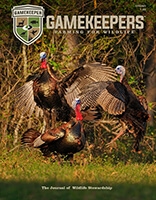With hunting season beginning there are always last-minute details you need to consider. Here are just a few catch-all items I’ve been thinking about and why I’ve prioritized getting them done before opening day.
Tree Stands
I’ve been a hunter education instructor for over 40 years, and one item our team thoroughly covers each session is deer stands. Climbing stands, ladder stands—we cover them all. That’s because there have been several accidents in our area. Regardless, many hunters still take stands for granted. Today, stands are well-built, but they are often left up year-round. So, before opening day, stands should be the first item on your list—whether it’s a hang-on stand or even a box blind. These stands are going to be your home for the next several months, weekend after weekend. To find out more, I contacted Glen Mayhew, Founding President of Tree Stand Safety Awareness (TSSA): https://treestandsafety.org
According to Mayhew, TSSA now recommends that hunters bring in each stand at the end of the season and store them. I know it’s easier to leave them out, but each day of exposure to weather and sunlight deteriorates stand components. Rust and UV rays damage straps, seats, cinch straps, bolts, and even coated cables.
If you did leave stands in the woods this year, don’t ascend the tree until you’re completely strapped into a full-body harness. Whether you’re inspecting the stand or putting it up for the first time, make sure you’ve already checked cinch straps, ratchet straps—anything used to secure the stand. We used to do a visual inspection and call it good, but Mayhew said, “We now recommend that all straps on a stand be replaced every two years, regardless of their condition. And don’t overlook climbing aids as well.” Also inspect all parts, cables, and bolts. If something doesn’t look right, replace it. But don’t go to the jar on your workbench or your local hardware store for replacements! A half-inch bolt may look the same, but it’s best to contact your manufacturer for certified parts. Tree-stand components are now built to national standards. Even straps and cable coverings with built-in UV protection should be ordered from your stand’s manufacturer.

Rob Kinney
During our hunter education classes, I ask, “Who hunts from stands?” In most cases, hunters don’t count tripods or quad stands as elevated stands—but they are. In recent years, there have been accidents involving both quad and tripod stands tipping over due to not being leveled or properly secured. If you have a homemade box blind like I do, go around all posts and check for cracks or rot. Also check the flooring, steps, and handrails. And if you don’t have handrails—add some.
Since Tree Stand Safety Awareness was formed, tree stand accidents have been declining. Mayhew said, “We had a decline before COVID hit, and then numbers climbed slightly because hunting activity was up during COVID.” The trend seems to resemble stairs—up and down year to year—but the overall trajectory is down, which is great news.
Mayhew also mentioned hunting saddles, which are gaining popularity among deer hunters. He said, “We are working with the National Bowhunter Education Foundation and Tree Stand Manufacturers Association (https://tmastands.com), along with the saddle industry, to develop the ABCs of Saddle Safety, which we plan to launch this fall in conjunction with our ABCs of Tree Stand Safety.” Check out TreeStandSafety.org.
Mayhew added another important recommendation: “Anytime you are putting up ladder stands, always use the number of people recommended by the manufacturer—which in most cases is three.”
Prior to the season, many bowhunters also practice from elevated stands. If you’re doing this, stay strapped in and wear a full-body harness. Mayhew said, “The good thing about this is that you’re practicing with your gear, which not only protects you but helps you get accustomed to shooting while wearing it. And don’t forget to use a haul line to pull your gear up and down.”
According to Mayhew, approximately 20 hunters die from tree stand falls each year—and that doesn’t include many more who are seriously injured. In 99% of these accidents, the hunter was not attached to the tree. Of those who fell, 86% were not wearing a safety harness, and another 35% of falls are attributed to faulty equipment.
The takeaway: Maintain three points of contact when climbing, wear a full-body harness attached above your head, ensure your stand is secure, and always use a haul line for your gear.
Boundary Lines
In the early 1900s, Robert Frost wrote, “Good fences make good neighbors.” Even without a fence, the same idea applies to well-marked boundary lines. Before the season rolls around, make a quick trip around your property lines to replace signs and check corner markers. About ten years ago, I began marking my boundaries with purple paint. Although my state hasn’t enacted a specific law, I hoped it would apply under the “Purple Paint Law.”
If you’re wondering what that is, nearly 20 states have implemented laws where purple paint signifies private property or no trespassing—carrying the same weight as a sign. This provides a clear message, and in many ways, it’s easier and cheaper than using signs that don’t last long.
Even if your state doesn’t have this law, painted lines still help designate boundaries. Since Texas implemented the law back in the late 90s, more states adopt it each year. Some states, like Maryland and Tennessee, use blue paint, while many western states use orange. Check out https://retipster.com/no-trespassing for an up-to-date state-by-state summary.
If you’re dealing with trespass issues, make sure you follow your state’s legal guidelines so that local game wardens can take action. It’s also smart to contact your local officer before opening day so they can familiarize themselves with your land and boundaries.
In any case, clearly marked boundaries help avoid misunderstandings between neighbors. Speaking of neighbors, as hunting season approaches, take a moment to touch base. While good fences are essential, don’t make yours so high that communication doesn’t happen. A simple phone call or visit goes a long way. I have my neighbors’ numbers, and we talk occasionally.
If you don’t have that relationship yet, now’s the time to build it. Introduce yourself, exchange numbers, and work out a plan in case a wounded deer crosses property lines. Maybe say, “We’ll give you a call if one crosses over—feel free to do the same. By the way, we’re having a cookout, why don’t you and your family stop by?” It’s always good to start the season on the right foot.

Rob Kinney
Check and Maintain Trail Cameras
Put trail cameras on your to-do list. Their use extends well beyond monitoring bucks. I used my first one in the 1980s, but the concept goes back even further—George Shiras set up the first “trail cam” in the 1880s using tripwires and large-format cameras to photograph wildlife.
Today, trail cams have countless applications. Justin Lanclos, Senior Product Evangelist for SpyPoint, said, “Before hunting season, your cameras need to be at peak performance. Hopefully by now, you already have an idea of the deer you’re targeting.”
From here on, maintenance is critical. Make sure batteries are good. Most modern cameras are far beyond old point-and-shoot models—they have firmware that must be kept up to date. Lanclos said, “With SpyPoint, you can update firmware remotely through the app. With our team constantly adding new updates, keeping the app current is essential.” One such feature allows filtering images by deer activity at specific times, helping refine patterns on your target buck.
Next, make sure no leaves, grass, or twigs are blocking the lens. Any movement can trigger false images. Lanclos added, “In some parts of the country, ants can build nests in or around cameras—keep ants under control as they can wreak havoc on equipment.”
As a senior citizen, I’ll admit I don’t manage cameras like I used to. I now rely on my son Josh to handle most of it. But when I recently bought a SpyPoint camera, I found it was “dummy-proof”—at least for an old guy like me. It works with a simple on-off switch and still gets the job done. Another use for trail cams is security. One option is a Vosker security camera, which offers a 90-degree field of view compared to the typical 45 to 50 degrees.

Rob Kinney
Zero Your Rifle and Tune Your Bow
Hopefully, this isn’t the last thing you do before the season—but for some, it is. There’s nothing worse than arriving at deer camp only to have someone sighting in their rifle within earshot of your stand. If possible, don’t practice where you hunt. Nothing broadcasts “opening day” louder than a rifle shot.
Hopefully, you’ve been practicing with your bow all summer and already zeroed your rifle at the range. Also, take one last loop around your trails. Mow them and clear fallen limbs. The quieter your entry, the better.
Your stands are solid, your cameras are working, and your trails are clean—but remember: your entire season may boil down to one opportunity. One shot—maybe two—and just 15 to 30 seconds to decide: shoot or don’t shoot. That’s why it’s so important to have your rifle zeroed and your bow dialed in. Now is not the time to wonder if that new broadhead will fly straight
-
Join our weekly newsletter or subscribe to Gamekeepers Magazine.
Your source for information, equipment, know-how, deals and discounts to help you get the most from every hard-earned moment in the field.









